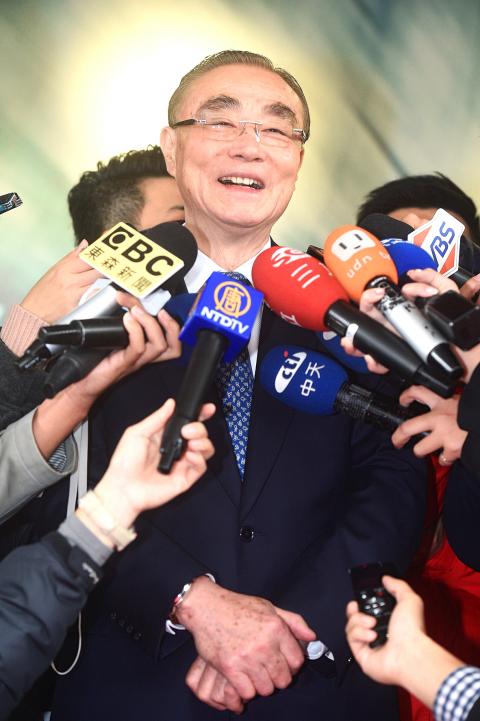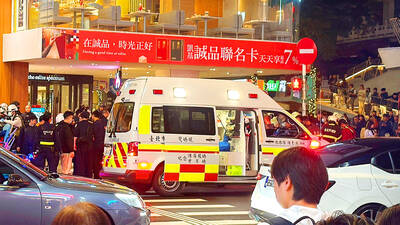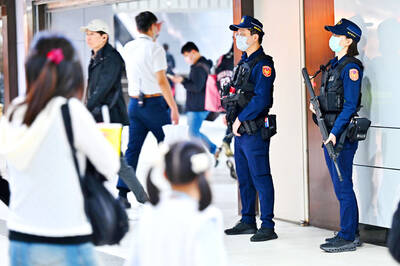China sailing its aircraft carrier near Taiwan has highlighted the need for the nation to go ahead with a plan to build its own submarines, Minister of National Defense Feng Shih-kuan (馮世寬) said yesterday.
The indigenous submarine project would not only protect the nation’s territorial security, but also allow Taiwan to contribute to regional security, Feng said at the opening of an exhibition on the history of the navy’s submarine fleet.
In what was seen by many as saber-rattling by Beijing, the Liaoning, China’s first aircraft carrier, sailed south in the Pacific Ocean off Taiwan’s eastern coast on Christmas Day before entering the South China Sea.

Photo: George Tsorng, Taipei Times
On Wednesday, the Liaoning passed through the Taiwan Strait on its way back to its base in northeastern China after conducting training exercises in the South China Sea.
The last time the aircraft carrier transited the Taiwan Strait was in November 2013.
At the ceremony, Feng said that the Ministry of National Defense publicized information to inform the public on the Liaoning’s movements, but stressed that “no special situations” were detected.
According to standing plans for the manufacturing of submarines, the ministry has been negotiating with CSBC Corp, Taiwan (台灣國際造船), the intended contractor, the ministry said, adding that if all goes according to plan, a prototype for the first submarines would undergo combat trials in 2024 and enter service in 2025.
Separately yesterday, former American Institute in Taiwan director Douglas Paal told the Central News Agency that recent aerial and maritime exercises by China’s armed forces near Taiwan were an example of Beijing showcasing its growing military strength and not a show of force directed at Taipei.
“As long as China’s military capabilities continue to grow, we expect to see Beijing expand its maritime activities in the days ahead,” Paal said.
Asked about saber-rattling by Beijing and demands that US president-elect Donald Trump abide by the “one China” policy, Paal said that as Trump has yet to assume office, all China can do is to issue stern statements to express its displeasure.
However, regarding Beijing’s recent threat to “take revenge” if Trump moves away from the “one China” policy, Paal said that the warning is real.
Asked if he expected Beijing to continue its effort to poach Taiwan’s diplomatic allies, such as the severing of diplomatic relations with Sao Tome and Principe on Dec. 20, Paal said the incident with the west African nation was probably driven by interests other than China’s desire to punish Taiwan.
Additional reporting by Aaron Tu

TRAGEDY STRIKES TAIPEI: The suspect died after falling off a building after he threw smoke grenades into Taipei Main Station and went on a killing spree in Zhongshan A 27-year-old suspect allegedly threw smoke grenades in Taipei Main Station and then proceeded to Zhongshan MRT Station in a random killing spree that resulted in the death of the suspect and two other civilians, and seven injured, including one in critical condition, as of press time last night. The suspect, identified as a man surnamed Chang Wen (張文), allegedly began the attack at Taipei Main Station, the Taipei Fire Department said, adding that it received a report at 5:24pm that smoke grenades had been thrown in the station. One man in his 50s was rushed to hospital after a cardiac arrest

SAFETY FIRST: Double the number of police were deployed at the Taipei Marathon, while other cities released plans to bolster public event safety Authorities across Taiwan have stepped up security measures ahead of Christmas and New Year events, following a knife and smoke bomb attack in Taipei on Friday that left four people dead and 11 injured. In a bid to prevent potential copycat incidents, police deployments have been expanded for large gatherings, transport hubs, and other crowded public spaces, according to official statements from police and city authorities. Taipei Mayor Chiang Wan-an (蔣萬安) said the city has “comprehensively raised security readiness” in crowded areas, increased police deployments with armed officers, and intensified patrols during weekends and nighttime hours. For large-scale events, security checkpoints and explosives

PUBLIC SAFETY: The premier said that security would be tightened in transport hubs, while President Lai commended the public for their bravery The government is to deploy more police, including rapid response units, in crowded public areas to ensure a swift response to any threats, President William Lai (賴清德) said yesterday after a knife attack killed three people and injured 11 in Taipei the previous day. Lai made the remarks following a briefing by the National Police Agency on the progress of the investigation, saying that the attack underscored the importance of cooperation in public security between the central and local governments. The attack unfolded in the early evening on Friday around Taipei Main Station’s M7 exit and later near the Taipei MRT’s Zhongshan

A car bomb killed a senior Russian general in southern Moscow yesterday morning, the latest high-profile army figure to be blown up in a blast that came just hours after Russian and Ukrainian delegates held separate talks in Miami on a plan to end the war. Kyiv has not commented on the incident, but Russian investigators said they were probing whether the blast was “linked” to “Ukrainian special forces.” The attack was similar to other assassinations of generals and pro-war figures that have either been claimed, or are widely believed to have been orchestrated, by Ukraine. Russian Lieutenant General Fanil Sarvarov, 56, head